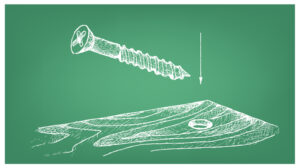 A countersunk screw, also referred to as a flathead, is a screw with a conical shape designed so that the screw head sits below or at the surface of the soft or hardwood it’s driven into. Countersinking is especially useful for hardwoods because the dense grain can make driving screws difficult, chewing up the wood grain and even snapping the head off the screw. Located in Canton, MA, Electronic Fasteners can help you select the right screw for any application.
A countersunk screw, also referred to as a flathead, is a screw with a conical shape designed so that the screw head sits below or at the surface of the soft or hardwood it’s driven into. Countersinking is especially useful for hardwoods because the dense grain can make driving screws difficult, chewing up the wood grain and even snapping the head off the screw. Located in Canton, MA, Electronic Fasteners can help you select the right screw for any application.
The use of a countersunk screw provides several benefits:
- It makes it easier to drive the screw and creates a better hold
- It preserves the integrity of the wood
- It provides a neater finished look – no raised head or splintered edges
- It enables a plug or cap to be used to cover the screw head and create a clean, unbroken appearance
Driving a screw into a hole that isn’t countersunk will create a very small point of contact, which applies a strong sheer force to the wood, tearing the wood grain. Hammering in a nail is the only thing worse. On the other hand, a countersunk screw has a large contact surface in a cleanly-cut wood funnel (a tapered hole that receives the tapered screw head above the open, drilled screw shaft). The resulting direction of the force is essentially downwards, where you want it to be.
The only tool needed for a countersunk screw – in addition to a screwdriver and drill – is a countersink drill bit. The drill bit can be secured in any chucked drill and will create a recess that enables a countersunk screw to sit flush with the surface of the material. The angle of the screw head determines the angle of the bit needed to allow the screw head to sit flush while maintaining contact with the base material.
If you’d like to explore our inventory to see what screws may be best for your next project, don’t hesitate to reach out to our experienced team at Electronic Fasteners.

